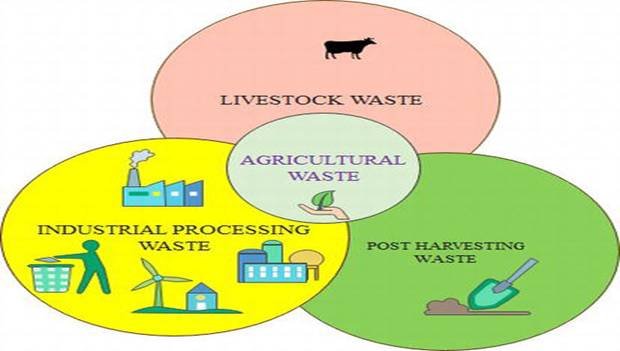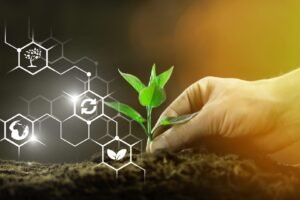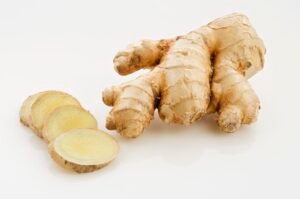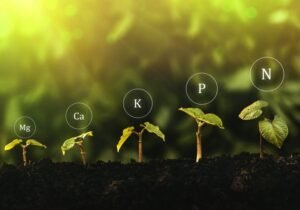How To Do Agricultural Waste Management?
Farming and Waste Management
Agriculture is the largest contributor of any resource sector and is also a largest generator of waste materials. Agriculture refers to the cultivation of animals, plants, fungi and other life forms for producing food, fibre, biofuel, drugs and other products that are used for the sustenance of human life.
Agriculture on one hand produces food and on the other hand, it produces waste. Therefore Agricultural waste management is very important to ensure that the waste does not harm the living creatures and the environment.
Chemical Fertilizer and Impact on Agriculture.
These wastes are composed of organic wastes, that are the animal excreta in the form of slurries and farm yard manure, and it also includes natural waste, plant wastes and chemical wastes.
The quantity of these wastes are usually huge and is generally hazardous, and if these wastes are not managed then it cannot only pollute water and air but it can also disrupt the process of farming.
We will study more about Waste Management in Farms in this article.
Introduction to Agricultural Wastes
There are a few things that are very certain in life – one is death, second is change and the other is waste. No one can stop these things from taking place in our lives but with better management we can prepare ourselves. Everyone has a right to clean air, water and food and it can only be fulfilled by maintaining a clear and healthy environment.

Now, the question arises here is – What is waste?
So, if we define waste then we can say that, “Any material which is not needed by the owner, producer or processor is waste. It is generally the end of the product life cycle which is disposed of.” Most of the businesses define it as, “Anything that does not create value”.
The livestock production has a great potential for Environmental Degradation and as a result of these activities, large volumes of gases, organic material, bacteria and other substances are produced which creates a risk factor for air, soil and water contamination.
High levels of effluents flow directly or indirectly into the surface waters and when the organic matter decomposes it produces methane gas. The anaerobic fermentation results in high Methane emissions which is released during the biological decomposition of the manure with the negative consequences for the farmers and livestock.
Top 10 Agriculture University In The World.
Agricultural Wastes – Classification
Farming activities are not the only source of producing waste, in fact, many food chains and the farming techniques also produce agricultural solid waste and at every step of the food chain there is some sort of wastes.
These includes:
- Food and Meat processing – Here crop and animal production results in some wastes known as abattoirs. The things like bones, banana peels, feathers and hoofs are categorised as solid waste.
- Horticulture – This solid waste comes from the maintenance and cultivation of plants. The waste produced here is by pruning and grass cutting.
- Animal production or livestock – This produces solid waste in the form of animal litter, water, trough, animal carcasses.
- Crop production – These wastes are produced in the form of Crop residues and husks.
- Industrial wastes – Besides producing food, the farming Industries produces raw materials and domestic products which leads to wastage. The production of paper utilises many agricultural products producing wastes. Wood cuttings and processing also produce waste.
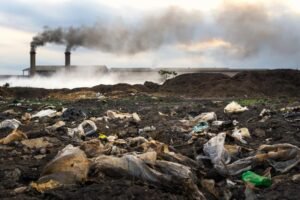
- On farm Medical – This wastage is due to the use of drugs, vaccines and insecticides on animals. The disposable needles, syringes or wrappers left from vaccines also contribute to waste.
- Chemicals – It is one of the most likely wastes on agricultural The use of pesticides, herbicides, insecticides or synthetic fertilizers pollute the environment. The farmers do not completely empty the pesticides and insecticides, rather they mishandle the containers and spill these chemicals in the nearby Ponds or fields which create environmental hazards, food poisoning risk and water pollution harming the animals, human and sea life.
What is the future of Agriculture & Farming?
There are some other common wastage such as:
- Kitchen waste
- Organic fertilizer bags
- Waste oil
- Manure & litter
Agricultural Waste Management
Waste can pollute surface and groundwater and contribute to air pollution, if they are not handled properly and proper management of waste from agricultural operations can contribute in a significant way to farm operation.
The management of waste helps in maintaining a healthy environment for farm animals and it can reduce the need for commercial fertilizers, providing other nutrients needed for crop production.
The wastes can give rise to the problem of landfills and emission of toxic gases from that particular area and if pesticides and insecticides end up in rivers instead of fields, then it can even kill aquatic life. They can pollute drinking water and kill animals who drink from it.
So animal agriculture, crop production and animal production and the use of pesticides results in environmental damage.
The world is shifting towards reducing the emission of greenhouse gases and animal production releases about 65% of nitrous oxide and 37% of Methane which are harmful greenhouse gases.
The burning of Agricultural solid wastes produces harmful emissions in a waste incinerator that results in climate change which leads to decrease in food production.
Ten Health Benefits of Being Vegetarian.
The wastes create Health & Environmental concerns as they end up in landfills. The high amount of gases emitted through these waste pollute the environment and contribute to climate change and also harms human health.
The dumped solid waste in waterways block the rivers which give rise to floods. These wastes are very harmful and puts everyone in danger, but to our surprise, these wastes can be easily recycled which can be beneficial for the soil fertility because it has high nutrient content and the recycling can contribute to sustainable agriculture production.
These waste also create Food Security concerns because of the increasing food insecurity in the world. As the years pass, the world population is increasing, thereby increasing the need for agriculture and food production which leads to agriculture and food waste.
The food insecurity is not because of insufficient food production but because of food wastage, as one third of the food produced is either lost or wasted. These waste can become a recyclable material to produce food ingredients which can result in higher animal protein production and can improve food security.
Waste Management Processes

Application & Use of Biotechnology In Agriculture.
The waste management process is divided into 6 steps:
- Source
- Generation
- Collection
- Transportation
- Treatment process
- Disposal
Generation – In India, 350 million tonnes of organic waste is annually produced from agriculture sources and the major quantity of solid waste generated are in the form of sugarcane baggage, paddy and wheat straw and husk, waste of vegetables, food products, tea, oil, jute fibres, groundnut shell wooden mill waste, coconut husk, cotton stalks, etc.
Collection – The fruit and vegetable waste are collected from houses called domestic waste. The other wastes are collected from roads, streets or sides and some waste like dry refuse and green waste or animal dung is collected from agricultural fields.
Transportation process – The waste that is collected from the side of roads or agriculture fields are Transported to a decomposed site for further treatment by trucks, trailers or carts.
Different types of wastes are collected which are then transported for further treatment and the waste which is not used is directly disposed of to the sanitary land. Wastes are not burnt in open air so it is transported to incineration.
Treatment process – Various types of treatment processes are performed on Agriculture wastes. The agricultural waste should be followed with proper health and safety regulations. We should provide a written instruction for storing and disposing each type of waste produced. The waste should be disposed of if they cannot be used for prevention, reusing, recycling or any other type of recovery method.
How to start commercial farming?
The treatment process is divided in 3 steps:
- Composting – Composting is a method in which organic matters are decomposed aerobically or anaerobically through a biochemical process which is then converted into humus. It is further divided into three steps:
- Preparation of agriculture wastes – This should be free of material that is not produced in agriculture wastes and should be free of dirt soil and visible surface and it should be arranged so that it will burn with a minimum of smoke.
- Decomposition – The wastes are decomposed in three ways – Nadep system, Vermiculture decomposition, Anaerobic decomposition.
- Product preparation and marketing
- Recycling – It is a process to change the waste into new products and these prevent waste of potential useful materials by reducing the consumption of raw materials and reducing energy usage. The incineration process reduces air pollution and water pollution from land filling and it also lowers Greenhouse gas emissions. The major key component of modern waste reduction is the third component of the “Reduce, Reuse, Recycle”.
- Incineration – It is a modern and most hygienic method of disposal of dry refuse and is widely used in western countries like USA, UK etc and in India it is popular in large cities. This method consists of burning the dry refuse in an incinerator.
How to do solar power fencing for crop protection?
Control of Solid Wastes
Farmers can set up a regular waste collection and can take measures to control the damages that they cause as in controlling fires while burning these wastes. Most of the waste can be put into better use which can facilitate agriculture production and can result in waste treatment and waste reduction.
Recycling and reusing this waste can be done in the following processes:
- paper making
- manufacturing glass
- mulching
- composting
- making organic fertilizers
- producing ethanol
- making additives in cement
- generating biogas
- making animal feed
- removing heavy metal
- generating electricity
One of the most popular ways to recycle crop waste is by Composting. Kitchen waste or crop waste can also come in use as animal feed, Fertilizer and bio energy by anaerobic digestion and fertilizer by composting. It can become a very good compost and fertilizer as they contain nutrients and organic matter. These wastes can also be managed by other ways apart from recycling, reusing or composting such as:
- Non conventional feeds
- Silica production
- Making soaps
- Energy source
Contribution of Farmers in Waste Management
Top crop producing states in India.
Farmers play an integral role in controlling the waste released by their work. The farmers should know the capacity and should not buy more than they need.
This means that they should analyse which products they use or do not use and which are usually left behind. They can limit the amount of product they need so that they do not need to dump it.
Also when they have some leftover pesticides or insecticides, do not dump them in waterways, instead they can consider selling them or giving it to other farmers. The same thing applies for surplus food products, they can either sell them in bulk at a lower price or donate them to charities and food banks, but do not render them as useless.
While planting crops, the farmers need to think carefully. They should not invest time and resources in plants that are not going to undergo a smooth harvest and if they cannot harvest these crops, they will simply go to waste. So, rather than this, better get involved in managing the crop growth by investing the resources in technologies that facilitate growth.
They can always think about recycling the waste. Composting should be an essential part of crop production and farming and there should be collection systems for organising waste. This will help reduce waste generators and organize what is left to further sell, distribute or compost.
Conclusion
Agricultural waste management is very crucial for saving the environment and life on the planet and if all the farmers take proper precautions about the wastage on farmland, it is only then that we can control the bulk of the waste. Therefore, it requires collective effort and a sense of responsibility to achieve it over time.

